HAIRSTYLES IN ANCIENT EGYPT
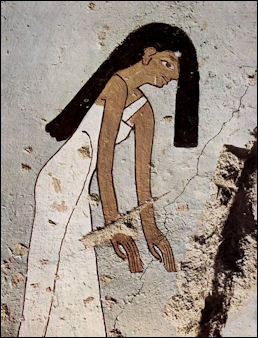
Egyptian men were usually clean shaven and sported both long and short hair styles. Men wore their hair long; boys had their heads shaved except for a lock of hair above their ear. A male body from a working class cemetery in Hierakonpolis dated around 3500 B.C. had a well trimmed beard.
Ancient Egyptians sported curls, braids, waves, twists, wigs and extentions, They dyed their hair and cut it short like U.S. Marines. Kozue Takahashi of Minnesota State University, Mankato wrote: “Egyptians threaded gold tubes on each tress, or strung inlaid gold rosettes between vertical ribs of small beads to form full head covers. The also used combs, tweezers, shavers and hair curlers. Combs were either single or double sided combs and made from wood or bone. Some of them were very finely made with a long grip. Combs were found from early tomb goods, even from predynastic times. Egyptians shaved with a stone blade at first, later with a copper, and during the Middle Kingdom with a bronze razor.” [Source: Kozue Takahashi, Minnesota State University, Mankato, ethanholman.com]
Women sometimes wore long things in their hair. A female body from a working class grave dated around 3500 B.C. had evidence of hair coloring (henna was used to color grey hair) and hair weaving (locks of human hair were tied to natural objects to produce an elaborate beehive hairdo). A grave in the worker’s cemetery at Hierakonpolis revealed a woman in her late 40s or early 50s with a Mohawk. Egyptians darkened grey hair with the blood of black animals and added false braids to their own hair.
The earliest combs are believed are believed to be fish bones. The earliest man-made combs were discovered in 6000-year-old Egyptian tombs. Some had single rows of teeth. Some had double rows of teeth.
Baldness was looked down upon. Chopped lettuce and ground-up hedgehog spines were applied to the scalp as a remedy for baldness. Other cultures have tried everything from camel dung to bear grease to achieve the same result. A male body from a working class cemetery in Hierakonpolis dated around 3500 B.C. had a sheepskin toupee used to hide a bald spot
Scholars often use hairstyles to date objects and even use them to determine foreign influences. .“There is evidence of influence from other cultures on Egyptian hairstyles. One example is the cultural union of the Roman Empire and the Egyptian empire. There is evidence of a female mummy wearing a typically Roman hairstyle yet the iconography on her death mask was plainly Egyptian. At Tell el-Daba in Egypt, there was a statue portrayed wearing a mushroom hairstyle that was typical of Asiatic males. There is a statue of young woman in the Ptolemaic period (304–30 B.C.) exhibiting a typical Nubian hairstyle consisting of five small clumps of hair. +\
Websites on Ancient Egypt: UCLA Encyclopedia of Egyptology, escholarship.org ; Internet Ancient History Sourcebook: Egypt sourcebooks.fordham.edu ; Discovering Egypt discoveringegypt.com; BBC History: Egyptians bbc.co.uk/history/ancient/egyptians ; Ancient History Encyclopedia on Egypt ancient.eu/egypt; Digital Egypt for Universities. Scholarly treatment with broad coverage and cross references (internal and external). Artifacts used extensively to illustrate topics. ucl.ac.uk/museums-static/digitalegypt ; British Museum: Ancient Egypt ancientegypt.co.uk; Egypt’s Golden Empire pbs.org/empires/egypt; Metropolitan Museum of Art www.metmuseum.org ; Oriental Institute Ancient Egypt (Egypt and Sudan) Projects ; Egyptian Antiquities at the Louvre in Paris louvre.fr/en/departments/egyptian-antiquities; KMT: A Modern Journal of Ancient Egypt kmtjournal.com; Egypt Exploration Society ees.ac.uk ; Amarna Project amarnaproject.com; Abzu: Guide to Resources for the Study of the Ancient Near East etana.org; Egyptology Resources fitzmuseum.cam.ac.uk
Body and Facial Hair in Ancient Egypt
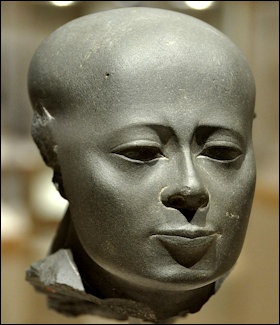
Egyptian men were generally clean-shaven and priests like the one above often shaved their heads
Cheryl Dawley of Minnesota State University, Mankato, wrote: “The Egyptians thought that an abundance of facial hair was a sign of uncleanliness and personal neglect. An exception to this was a man's thin mustache or goatee. There was no soap so an oil or salve was probably used to soften the skin and hairs of the area to be shaved. Tweezers with blunt or sharp ends were used for removing individual facial hairs.” [Source: Cheryl Dawley, Minnesota State University, Mankato, ethanholman.com]
Kozue Takahashi, of Minnesota State University, Mankato wrote: “In ancient Egypt, men and women used to shave their heads bald replacing their natural hair with wigs. Egyptian women did not walk around showing their bald heads, they always wore the wigs. Head shaving had a number of benefits. First, removing their hair made it much more comfortable in the hot Egyptian climate. Second, it was easy to maintain a high degree of cleanliness avoiding danger of lice infestation. In addition, people wore wigs when their natural hair was gone due to old age. However, even though the Egyptians shaved their heads, they did not think the bald look was preferable to having hair.” [Source: Kozue Takahashi, Minnesota State University, Mankato, ethanholman.com]
“Priests were required to keep their entire bodies cleanly shaved. They shaved every third day because they needed to avoid the danger of lice or any other uncleanness to conduct rituals. This is the reason why priests are illustrated bald-headed with no eyebrows or lashes. +\
Hairstyles and Identify in Ancient Egypt
In ancient Egypt, hair styles were often expressions of identity, religious position and class. Style and class were just as important in the afterlife. A study of 18 mummies by the University of Manchester revealed that many had their hair coated wtih a fatty substance. [Source: National Geographic]
Kozue Takahashi of Minnesota State University, Mankato wrote: “For ancient Egyptians, appearance was an important issue. Appearance indicated a persons status, role in a society or political significance. Egyptian hairstyles and our hairstyles today have many things in common. Like modern hairstyles Egyptian hairstyles varied with age, gender and social status. [Source: Kozue Takahashi, Minnesota State University, Mankato, ethanholman.com +]
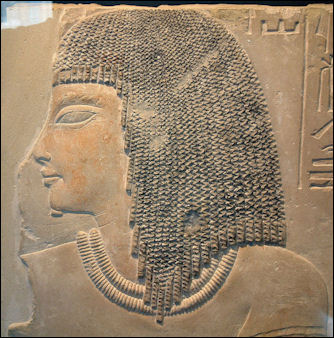
“Children had unique hairstyles in ancient Egypt. Their hair was shaved off or cut short except for a long lock of hair left on the side of the head, the so-called side-lock of youth. This s-shaped lock was depicted by the hieroglyphic symbol of a child or youth. Both girls and boys wore this style until the onset of puberty. Young boys often shaved their heads, while young girls wore their hair in plaits or sometimes did up their hair in a ponytail style, hanging down the center of the back. Young girl dancers used to wear long thick braided ponytails. The edge of the tail was either naturally curled or was enhanced to do so. If the ponytail was not curled at the end, it was weighted down by adornments or metal discs. +\
“Egyptian men typically wore their hair short, leaving their ears visible. Men often kept these hairstyles until their hair began to thin with advancing age. Another hairstyle for men was distinctive short curls covering the ears shaping a bend from temple to nape. It is doubtful that this hairstyle was natural. It was more likely a result of a process of hair curling that was done occasionally. +\
“Women's hairstyles were more unique than those of men. Women generally preferred a smooth, close coiffure, a natural wave and long curl. Women in the Old Kingdom preferred to have short cuts or chin length bobs. However, women in the New Kingdom (1550–1070 B.C.) wore their hair long or touted a wig. Women tied and decorated their hair with flowers and linen ribbons. A stylized lotus blossom was the preferred adornment for the head. This developed into using coronets and diadems. Diadems made of gold, turquoise, garnet, and malachite beads were discovered on an ancient Egyptian body dating to 3200 B.C. Poorer people used more simple and inexpensive ornaments of petals and berries to hold their hair at the back. Children decorated their hair with amulets of small fish, presumably to protect from the dangers of the Nile. Children sometimes used hair-rings or clasps. Egyptians wore headbands around their heads or held their hair in place with ivory and metal hairpins. Beads might be used to attach wigs or hair extensions in place. +\
“Slaves and servants were not able to dress the same as Egyptian nobility. The way that they adorned their hair was quite different. Commonly, they tied their hair at the back of the head into a kind of loop. Another type of hairstyle was to tie it in eight or nine long plaits at the back of the head and to dangled them together at one side of the neck and face. +\
Wigs in Ancient Egypt
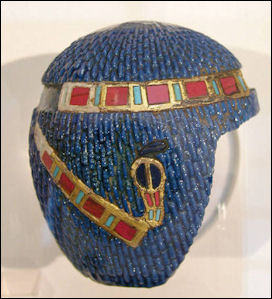
Wigs were popular in ancient Egypt as they were in ancient Mesopotamia, Crete, Persia and Greece. Egyptian ones were made from vegetable fiber such as linen, sheep wool, animal hair or human hair stiffened with beeswax. The earliest known ones date back to around 3000 B.C. Many ancient Egyptian wigs have survived in relatively good condition and several museums and universities have fine collections of them.
Wigs were worn at major festivals and events. Members of the upper classes possessed many wigs, elaborate double wigs with intricate braids and curls, curls kept in place with beeswax and hair bands ending in tassels. Most Pharaohs had short cropped hair. The head coverings you see on mummy cases and giant statues are the not headdresses or natural hair but wigs. Pharaohs wore false beards, with length indicating status. False beards were even popular with some Egyptian queens. During Nefertiti’s reign ordinary people started wearing wigs. A luxurious wig stiffened with beeswax was a powerful sexual symbol that linked the wearer to Hathor, the goddess of beauty.
Egyptian wigs tended to be helmet-like structures. Some were bright green, blue or red in color and some were adorned with precious metals and stones. Other were quite massive. One worn by Queen Isimkheb in 900 B.C., weighed so much she needed help from her attendants to stand up. Currently kept in the Cairo Museum, it was made entirely from brown human hair and held together by beeswax.
Cheryl Dawley of Minnesota State University, Mankato, wrote: “Wigs and hairpieces were also quite popular. They were quite elaborate and usually made of human hair. Other tools used in the beauty ritual that have been found include short fine tooth combs, hair pins, and a small bronze implement with a pivoting blade thought to be a hair curler.” [Source: Cheryl Dawley, Minnesota State University, Mankato, ethanholman.com]
Kozue Takahashi, of Minnesota State University, Mankato wrote: “Wigs were worn by men, women and children. They were adorned both inside and outside of the house. Egyptians put on a new wig each day and wigs were greatly varied in styles. The primary function of the wig was as a headdress for special occasions, such as ceremonies and banquets. [Source: Kozue Takahashi, Minnesota State University, Mankato, ethanholman.com +]
“Wigs were curled or sometimes made with a succession of plaits. Only queens or noble ladies could wear wigs of long hair separated into three parts, the so-called goddress. However, they were worn by commoners in later times. During the Old and Middle Kingdom, there were basically two kinds of wig styles; wigs made of short or long hair. The former was made of small curls arranged in horizontal lines lapping over each other resembling roof tiles. The forehead was partially visible and the ears and back of the neck were fully covered. Those small curls were either triangular or square. The hair could be cut straight across the forehead or cut rounded. +\
“On the contrary, the hair from a long-haired wig hung down heavily from the top of the head to the shoulders forming a frame for the face. The hair was slightly waved and occasionally tresses were twisted into spirals. In the New Kingdom, people preferred wigs with several long tassel-ended tails, while shorter and simpler wigs became popular in the Amarna period. +\
Care of Wigs in Ancient Egypt
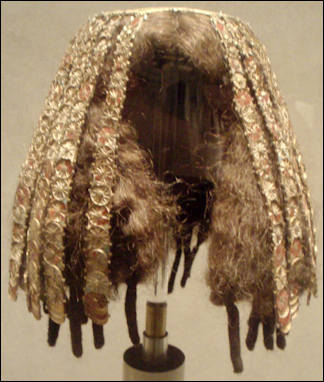
Wig cover from Tomb of
Three Minor Wives of Thutmose III
Kozue Takahashi, of Minnesota State University, Mankato wrote: ““Wigs were meticulously cared for using emollients and oils made from vegetables or animal fats. Those wigs that were properly cared for lasted longer than those without proper care. Although Egyptians preferred to wear wigs and took care of them, they also did take care of their natural hair. Washing their hair regularly was a routine for Egyptians. However, it is not known how frequently Egyptians washed their hair. [Source: Kozue Takahashi, Minnesota State University, Mankato, ethanholman.com +]
“Wigs were scented with petals or piece of wood chips such as cinnamon. When wigs were not used, they were kept in special boxes on a stand or in special chests. When it was needed, it could be worn without tiresome combing. Wig boxes were found in tombs and the remnants of ancient wig factories have been located. Since it is believed that wigs were also needed for the afterlife, the dead were buried in the tombs with their wigs. +\
“Wigs were usually made from human hair, sheep's wool or vegetable fibers. The more it looked like real hair, the more expensive it was and the more it was sought after. Wigs of high quality were made only from human hair, while wigs for the middle class were made with a mix of human hair and vegetable fibers. The cheapest wigs were made fully from vegetable fibers. Both wig making specialists and barbers made the wigs and wig making was considered to be a respectable profession. It was one of the jobs available to women. People cut or shaved their hair by themselves or went to the barbers. A barbershop scene is depicted in the tomb of Userhet at Sheikh Abd el-Qurna, where young men are forming a waiting line, sitting on the folding chairs and tripods while the barber is working. +\
Hair Dyes, Gels and Oils in Ancient Egypt
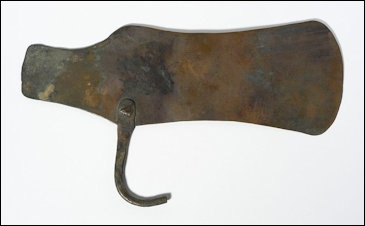
ancient Egyptian razor
Kozue Takahashi, of Minnesota State University, Mankato wrote: ““Egyptians used a material called henna (used for nails and lips, too) to dye their hair red. Scientific studies show that people used henna to conceal their gray hair from as early as 3400 B.C. Henna is still used today. There is a body of evidence from paintings that depict the existence of people with red hair, such as the 18th Dynasty Hunutmehet. She had distinctive red hair mentioned by Grafton Smith. [Source: Kozue Takahashi, Minnesota State University, Mankato, ethanholman.com +]
“Like today, ancient Egyptians were also facing the same problem of hair loss, and they wanted to maintain their youthful appearance as long as possible. There were many kinds of suggested remedies targeting primarily men. In 1150 B.C., Egyptian men applied fats from ibex, lions, crocodiles, serpents, geese, and hippopotami to their scalps. The fat of cats and goats was also recommended. Chopped lettuce patches were used to smear the bald spots to encourage hair growth. +\
“Ancient Egyptians also made use of something similar to modern aromatherapy. Fir oil, rosemary oil, (sweet) almond oil and castor oil were often used to stimulate hair growth. The seeds of fenugreek, that plant herbalists and pharmacologists still use today, was another remedy.”
Ancient Egyptian 'Hair Gel'
The ancient Egyptians styled their hair using a fat-based 'gel', an analysis of mummies announced in 2011 revealed. The researchers who did the study said that the Egyptians used the product to ensure that their hair stayed they way they wanted in both life and death. The study was led by Natalie McCreesh, an archaeological scientist from the KNH Centre for Biomedical Egyptology at the University of Manchester in Britain. Her team studied hair samples from 18 mummies. The oldest was around 3,500 years old, but most were excavated from a cemetery in the Dakhleh Oasis in the Western Desert, and date from Greco-Roman times, around 2,300 years ago. They include males and females ranging in age from 4 to 58 years old. Some were artificially mummified; others were preserved naturally by the dry sand in which they were buried. The results are published in the Journal of Archaeological Science.[Source: Jo Marchant, Nature, 19 August 2011]
Jo Marchant wrote in Nature: Microscopy using light and electrons revealed that nine of the mummies had hair coated in a mysterious fat-like substance. The researchers used gas chromatography–mass spectrometry to separate out the different molecules in the samples, and found that the coating contained biological long-chain fatty acids including palmitic acid and stearic acid. McCreesh thinks that the fatty coating is a styling product that was used to set hair in place. It was found on both natural and artificial mummies, so she believes that it was a beauty product during life as well as a key part of the mummification process.
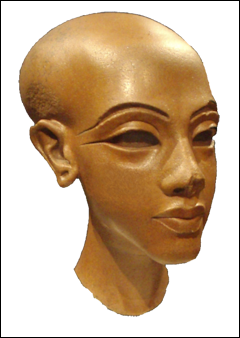
“The resins and embalming materials used to prepare the artificially mummified bodies were not found in the hair samples, suggesting that the hair was protected during embalming and then styled separately. "Maybe they paid special attention to the hair because they realized that it didn't degrade as much as the rest of the body," says McCreesh. The product was found on both male and female mummies, showing that both sexes cared about their eternal hairdo.”
John Taylor, head of the Egyptian mummy collection at the British Museum in London, told Nature that Egyptian texts and art contain no mention of hair products, although ancient Egyptians are known to have used scented oils and lotions on their bodies. "The best clue comes from Egyptian wigs," says Taylor. "The hair is often coated with beeswax." Such wigs, which have been found in Egyptian tombs, would have been expensive and probably restricted to the nobility, says McCreesh. "The majority of the mummies I've looked at have their own hair," she says.
“The Egyptians might have also used beeswax on their own hair. The wax contains fatty acids such as palmitic acid, although McCreesh says that her results so far don't show any evidence of beeswax. "It was a fat, but we can't tell you what type of fat," she says. She points out that beeswax would be difficult to wash out of hair, compared to, say, animal fat. She now plans to analyse the samples further, to try to pin down the hair-gel recipe.
“The mummies' hairstyles varied, both long and short, with curls particularly popular; metal implements resembling curling tongs have been found in several tombs. Once the hair was styled, the fatty gunge would have held the individuals' curls in place. "You can almost imagine them when they were alive," says McCreesh, "tending their hair and putting their curls in."
Hair Extensions in Ancient Egypt
Wigs were very expensive. Hair extensions were a cheaper alternative and were often preferred because they could be tied up in the back. Sometimes they were used to enhance wigs as Egyptians regarded thick hair as the ideal. In 2014, scientists announced they had found an unmummified 3,300-year-old Egyptian with a complex hairdo that included 70 different extensions. [Source: Rachel Feltman, Washington Post, September 17, 2014 ==]
.jpg)
ancient Egyptian hair pieces The hairdo was likely styled after death, and was held in place with animal fat. Archaeologist Jolanda Bos told Live Science that the woman probably used extensions in her day-to-day life — but we just can't be sure. "Whether or not the woman had her hair styled like this for her burial only is one of our main research questions," said Bos. ==
Rachel Feltman wrote in the Washington Post: “This coiffed corpse is just one of many that Bos is studying, all found in the cemetery of an ancient city we now call Amarna. She's looking at their hair to learn more about their city. Variation in hair type indicates that it was an ethnically diverse area, and the different styling techniques — which include many extensions, sometimes from multiple hair donors, even though all styles were kept around 12 inches long or less — will help her understand their culture.” ==
Image Sources: Wikimedia Commons, The Louvre, The British Museum, The Egyptian Museum in Cairo
Text Sources: UCLA Encyclopedia of Egyptology, escholarship.org ; Internet Ancient History Sourcebook: Egypt sourcebooks.fordham.edu ; Tour Egypt, Minnesota State University, Mankato, ethanholman.com; Mark Millmore, discoveringegypt.com discoveringegypt.com; Metropolitan Museum of Art, National Geographic, Smithsonian magazine, New York Times, Washington Post, Los Angeles Times, Discover magazine, Times of London, Natural History magazine, Archaeology magazine, The New Yorker, BBC, Encyclopædia Britannica, Time, Newsweek, Wikipedia, Reuters, Associated Press, The Guardian, AFP, Lonely Planet Guides, “World Religions” edited by Geoffrey Parrinder (Facts on File Publications, New York); “History of Warfare” by John Keegan (Vintage Books); “History of Art” by H.W. Janson Prentice Hall, Englewood Cliffs, N.J.), Compton’s Encyclopedia and various books and other publications.
Last updated September 2018
